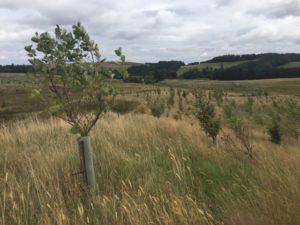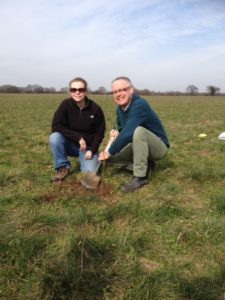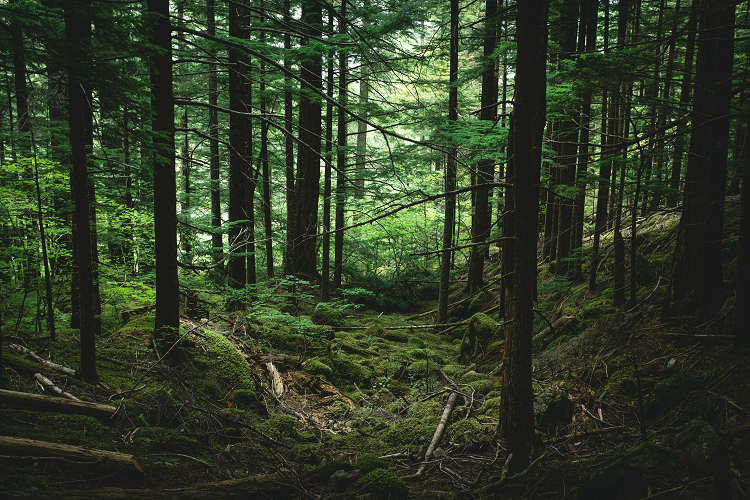An Introduction to Woodland Carbon; A Growing Source of Funding for Woodland Creation
15 October 2020Woodlands can make a significant contribution to tackling climate change – in 2017 Scotland’s woodlands sequestered 9.5 million tonnes of CO2e, reducing Scotland’s net annual emissions to 40.5 million tonnes CO2e.
The Climate Change (Emissions Reduction Targets) (Scotland) Act 2019 commits Scotland to have net zero greenhouse gas emissions by 2045 – 5 years earlier than the rest of the UK. Recognising the role that woodlands and carbon sequestration have to play, Scottish Government have made the following commitments within the latest Programme for Government (2020-21):
- Increase the planting targets from 12,000 to 18,000 hectares per year by 2024-25 with increased grant funding to help with this.

- Grants of up to £20,000 for farmers and crofters to purchase new equipment through the Sustainable Agriculture Capital Grant Scheme (SACGS)
(closes midnight Sunday 11th of October 2020) - Increase the size of the woodland carbon market by 50% in 5 years.
It is only mandatory for businesses in energy and some industrial sectors to reduce their emissions but there is a rapidly increasing desire amongst other businesses to voluntarily reduce their emissions to help meet these ambitious targets. Reaching net-zero is going to require we create more woodlands and restore our degraded peatlands.
Carbon without the jargon
| Carbon sequestration | Capturing and securely storing carbon that would otherwise be in the atmosphere. As a very rough guide, around one quarter of a tree is solid stored carbon. Note this varies greatly between species, where and how they grow, what age they are. |
|---|---|
| CO2e | Carbon dioxide equivalent. Used to equate the warming effects of other greenhouse gases, such as methane and nitrous oxide, with CO2 |
| PIU | Pending Issuance Unit |
| tCO2 | Tonnes of carbon dioxide |
| WCC | Woodland Carbon Code |
| WCU | Woodland Carbon Unit |
| YC | Yield class. A measure of productivity. YC is the average annual gain in timber volume per hectare per year over the rotation. For example, a yield class of 16 indicates an average annual timber volume gain of 16m3/ha/yr. Yield class varies between species (some grow faster than others) and site conditions. |
Woodland and peatland – a rapidly developing carbon market
The Woodland Carbon Code (WCC), launched in 2011, is the UK’s government-backed standard for woodland carbon projects. It applies similar standards to other global carbon initiatives but is tailored to UK conditions and legislation. It provides the mechanism for landowners creating woodland to engage in the carbon market in the UK. The scheme is based on robust carbon prediction tools and monitoring protocols developed by Forest Research. New woodlands meeting the standard have to be third-party checked as being sustainably managed and meeting high carbon standards, giving confidence to buyers.
So far, over 500 woodland creation projects have registered across the UK. More than half of these are validated by an independent validation body (Acoura or Soil Association) to check they are well set up and meet the standards set out in the WCC. Over 90 projects so far (those set up earliest) have verified the amount of carbon sequestration after 5 years. Over 40% of projects are in Scotland. The registered projects across the UK will create over 20,000 hectares of woodland and are predicted to sequester almost 8 million tonnes of carbon dioxide over their lifetime (up to 100 years).
The Peatland Code, a standard managed by the International Union for Conservation of Nature (IUCN), has four peatland restoration projects validated and 13 registered in total. The Peatland Code has similar principles to the WCC. See the IUCN website for more information.
How do you apply?
-
-
- Decide whether you want to go through this process yourself, or ask a project developer to help. If you only have one small project it’s probably easier to ask a project developer to help. If you have a large project or are likely to go through the process more than once you might consider taking the time to learn the process and DIY. The WCC team are available to advise you.
- Check you’re eligible and register your project on the UK Woodland Carbon Registry. You’ll need basic information about the project/site and use that to do a carbon sequestration projection. You need to make sure:
-
- you’re committed to permanent land use change to woodland
- you’re registering within 6 months of the start of planting*
- the land hasn’t been wooded for at least 25 years
- planted areas are not deep peat (less than 50cm organic/peat layer)
- the woodland creation is ‘additional’ – it’s not legally required, and it’s the carbon finance that will make the project viable.
-
-
-
- Complete documentation and get validated – You’ll need to complete a ‘Project Design Document’, and supply relevant information, whilst you are planning and planting your woodland, then get Acoura or Soil Association to look over your documentation. This can’t be finished until all trees are in the ground but you have 3 years from registration to complete this process.
- Stay Verified – at year 5 and then every 10 years, survey your site, complete a ‘Progress Report’ and get Acoura or Soil Association to verify your documentation. Projects can be up to 100 years long – you decide how long to commit.
-
*Currently you have to register within 2 years of the start of planting but deadline will soon change to 6 months.
Getting involved – costs and likely income
There are a growing number of ‘project developers’ who are willing to help landowners put their projects through the Woodland Carbon Code. If you use a third-party project developer, they may take on some or all of the responsibility and cost of validating, monitoring and verifying the woodland carbon project over its lifetime. This leave the landowner with a smaller share of the carbon income but also less future responsibility/cost – you can decide how involved you want to be.
There’s a simpler process for small (≤5ha) projects, and projects can be ‘grouped’ for cheaper validation/verification – this needs a project developer to act as ‘group manager’. You shouldn’t need much more information about a project than you would normally supply when applying for a woodland creation grant. You can use our tools to work out the likely carbon sequestration of your project.
Feedback from project developers suggests corporate buyers currently pay between £7 and £20 when buying WCC units upfront – with increased demand, prices have been rising. The majority of the volume, however, is towards the lower end of this bracket.
Table 1 shows the likely costs and income for three different scenarios: a 10ha native woodland; a group of 10 x 5ha native woodlands; 30ha of productive Sitka spruce woodland (including 25% mixed broadleaves). Validation/verification is a fixed cost per project (~£1000 if no site visit required) whereas registry fees are volume-based (£0.09 total per carbon unit/tCO2). There are time and cash savings for validation/verification as a group. Verification could cost more if site visits are required past year five (only applies to ‘risky’ projects). For a native woodland which could generate almost 400 tCO2/ha over 100 years, potential income from carbon credits (at £7 to 15/tCO2) is £2,700 to 5,800/ha. Taking off the cash cost of involvement the net income could be up to £5,000/ha (at £15/tCO2), although you still need to consider the time to undertake survey work and complete documentation.
Table 1: Costs and possible income from native and productive WCC projects
| Type of project | 10ha Mixed Native Woodland (YC4, 2.5m spacing, minimum intervention) | 10 x 5ha Mixed Native Woodlands Validated as a group (YC4, 2.5m spacing, minimum intervention) | 30ha Productive Woodland (75% of net area Sitka spruce YC16, thinned & felled at year 50, 25% of net area mixed broadleaves, YC4, minimum intervention) | ||||
|---|---|---|---|---|---|---|---|
| Project length | 100 years | 100 years | 100 years | ||||
| Total | Per Hectare | Total | Per Hectare 386 | Total | Per Hectare |
||
| Saleable carbon (tCO2) | 3,860 | 386 | 19,300 | 386 | 6,780 | 226 | |
| Costs - Time (Can be undertaken by landowner or third-party project developer) | For all projects, prepare validation documents at start, undertake survey +5 and every 10 years, prepare verification documents +5 and every 10 years, liaise with validation/verification body and keep registry up to date | ||||||
| Cost - Cash Validation/ Verification and Registry Use | £13,000 | £ 1,300 | £ 32,400 | £ 648 | £ 8,000 | £ 267 | |
| Carbon Income £/tCO2 | £7 | £27,020 | £ 2,702 | £ 135,100 | £ 2,702 | £ 47,460 | £ 1,582 |
| Carbon Income £/tCO2 | £10 | £38,600 | £ 3,860 | £ 193,000 | £ 3,860 | £ 67,800 | £ 2,260 |
| Carbon Income £/tCO2 | £15 | £57,900 | £ 5,790 | £ 289,500 | £ 5,790 | £ 101,700 | £ 3,390 |
| NET (Carbon Income Minus Cash Costs) £/tCO2 | £7 | £14,020 | £ 1,402 | £ 102,700 | £ 2,054 | £ 39,460 | £ 1,315 |
| NET (Carbon Income Minus Cash Costs) £/tCO2 | £10 | £25,600 | £ 2,560 | £ 160,600 | £ 3,212 | £ 59,800 | £ 1,993 |
| NET (Carbon Income Minus Cash Costs) £/tCO2 | £15 | £44,900 | £ 4,490 | £ 257,100 | £ 5,142 | £ 93,700 | £ 3,123 |
Assumptions: 20% of carbon units are put into shared ‘buffer’ – a pool of units which cannot be sold and will be called upon if there are any future losses of carbon from any WCC project.
If you can find a buyer for the carbon in the early stages of the project it is possible to receive all the carbon income upfront. You would need to consider the ongoing requirement to monitor and verify this project, and the potential liability you would hand to a subsequent owner if you sell the holding within the timeframe of any carbon contract. If you wait and sell carbon units as they are delivered and verified, this would guarantee the project a fairly regular income over the life of the project. This income could pay for management, monitoring and verification costs as the project proceeds, and means if you want to sell the holding you are passing on an asset of unsold carbon.
Carbon seller case study: Tweed Forum Group.
Three woodland creation projects in upstream areas of the Tweed catchment, Shiplaw Burn, Mowhaugh and Halterburnhead, were validated as a group through Forest Carbon. See Case Studies of WCC projects.
Hugh Chalmers from Tweed Forum says:
“Tweed Forum is co-ordinating a whole catchment management project to improve the condition of rivers and to demonstrate natural flood management in the Eddleston Water sub-catchment. We approached the landowner-farmer to suggest planting 17ha of native woodland along Shiplaw Burn. After discussions on the multiple benefits which would be gained by tree planting, the farmer was enthusiastic but was unable to contribute financially to the initiative. Tweed Forum looked elsewhere to find funds to make the project work financially, especially up-front costs for fencing and tree planting, as the FC grant did not cover the whole costs of the scheme. Forest Carbon was approached: they dealt with the WCC application and validation; an agreement to purchase some of the carbon to be captured by the woodland was agreed. A lump sum of around £13,000 was made available when trees were planted, to make the project financially viable.”
How do I sell my carbon units?
Over 50% of 2.6 million validated carbon credits have been sold upfront and almost all the verified credits are sold (there’s only 7,000). There are a number of ways to find a buyer:
- Ask locally. Some businesses like to buy from a ‘local’ project – ie one they can visit or state is near to their customers. Yorkshire Dales Millennium Trust have found a number of Yorkshire buyers.
- We’ll advertise your project on the WCC website. Once your project is validated we can advertise your project to companies looking to buy.
- Use an intermediary. There are a number of ‘intermediaries’ who advise their corporate clients on reducing their GHG emissions, and also offer them carbon units from WCC projects. These are companies such as Climate Care, EcoAct, Natural Capital Partners, and South Pole. Project developers including Forest Carbon and the Woodland Trust can also help you find a buyer.
- Use Markit Registry. They offer a service called the ‘Request for Information Platform’ which is a bit like ‘Gumtree’ for carbon units. You can place your units ‘for sale’ with details of the price you’re looking for so other Markit Registry account holders can contact you for more information.
Who buys WCC units and why?
Over 400 different businesses covering a wide range of sectors such as food & drink, furniture, paper & lighting manufacturers, and transport have purchased woodland carbon. They want to buy locally, they like
woodlands as they are ‘tangible’ and come with many other social and environmental benefits aside from carbon. BWOC, a fuel distribution company, state that one of the benefits of buying from a WCC project is that it has brought more business by helping them win public sector contracts. The Green Investment Bank really valued the opportunity to get their staff onsite to help with tree planting.
Carbon buyer case study: Waitrose
Waitrose, through the Woodland Trust, has bought carbon from a large native woodland creation project in Cumbria. The aim, over time, is to compensate for the GHG emissions of their home delivery fleet. They were particularly attracted by the potential for woodlands to improve biodiversity and control flooding. Working with the Woodland Trust on these projects raises their social and environmental corporate responsibility credentials, as well as providing them with a strong marketing message. Involvement with the project also provides opportunities for staff engagement through tree planting days.
See more buyer case studies on the WCC website.
Looking to the future
Over the last 6 to 12 months interest in woodland carbon has increased rapidly across the UK. Greater numbers of landowners and agents, as well as corporate buyers, are becoming involved. For farmers, crofters and other landowners, if you’re struggling to fully fund a woodland creation or peatland restoration project it’s worth looking to the carbon market for some extra income to help move your project from idea to reality.
Further Information
Dr Vicky West, Woodland Carbon Code ManagerScottish Forestry
This article has been published in the Autumn2020 edition of the Farm Woodland News. Download a copy to access all articles. Subscribe to receive newly published editions via email by using the form here.
Sign up to the FAS newsletter
Receive updates on news, events and publications from Scotland’s Farm Advisory Service



